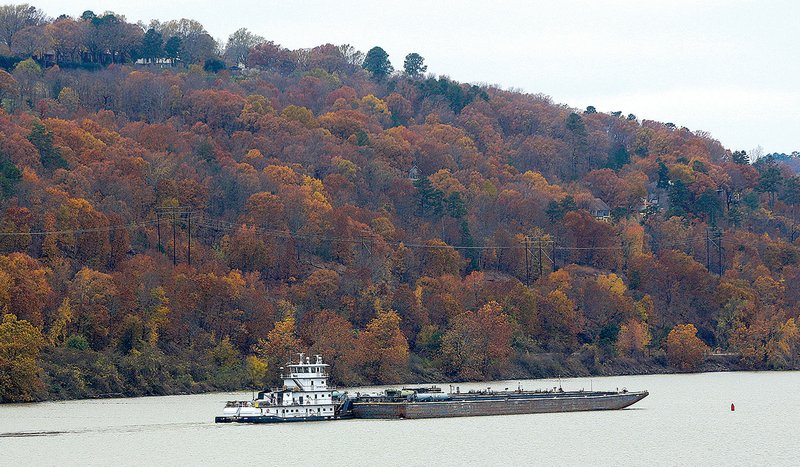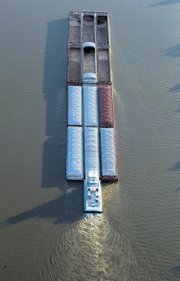With the third-largest number of navigable, inland waterway miles in the nation, Arkansas is a logical headquarters for the Maritime Transportation Research and Education Center.
The center, at the University of Arkansas at Fayetteville, is one of the nation's top maritime multimodal research centers.
MarTREC, as the center is commonly known, first opened in 2013 within the Mack-Blackwell Transportation Center. In December, the U.S. Department of Transportation announced that it would renew and increase funding for MarTREC, to the tune of $7 million.
The center is a consortium of six universities, but the University of Arkansas is the lead and distributes the grant. MarTREC's nationally recognized group of researchers studies the nation's inland waterways and how to best move cargo on and around them.
However, its existence is something of an accident.
Heather Nachtmann, a professor of industrial engineering and the director of MarTREC, conducted her first research related to maritime multimodal transportation in 2001, when a project on the economic impact of Arkansas' waterways was unexpectedly left without someone to finish it. Nachtmann had a background in economic impact studies and agreed to take over the $7,000 project.
From there, Nachtmann has built a specialty for herself and the school, from that original project to the $7 million MarTREC just received.
"I always tell our new faculty: Don't overlook new opportunism," she said. " Seven-thousand dollars is very, very small. But if I had said no, I probably would never have gotten into this area."
Arkansas has five navigable rivers. The Arkansas River is the busiest with 10 million tons of freight in 2015 running from Catoosa, Okla., to the Mississippi River. Still, according to Gene Higginbotham, executive director of the Arkansas Waterways Commission, the state's waterways are "a resource we haven't fully developed yet."
Each towboat on the river pushes between nine and 15 barges at a time, and each barge holds about 60 truckloads of product. Bryan Day, executive director of the Little Rock Port Authority, said shifting that onto the roads would require nearly 1,000 tractor-trailers.
"And that's just one tow," he said. "We move thousands of tows a year. If that river system didn't exist, all that commodity we're moving through Arkansas would have to be on the interstate highway system, which couldn't accommodate it."
And transport by water is cheaper. The Arkansas Waterways Commission estimates that the cost per ton per mile on a barge is 97 cents, compared with $2.53 on rail and $5.35 on a truck.
"It's also the safest mode of transportation and the most environmentally friendly, because it uses the least amount of fuel," Nachtmann said.
Research conducted under the center's umbrella varies but falls into three main categories, Nachtmann said. One echoes the theme of the latest government grant -- upgrading the infrastructure of the waterways, notably the aging pumps and gates of the lock and dam system that enables rivers like the Arkansas to stay deep enough to handle the cargo.
Another type of study involves logistics: research that helps target where ports could be upgraded to maximize their use and accessibility for specific industries.
"The highways are so congested, and they are getting so worn, but there's capacity on the waterways," she said. "So what we need to try to do is make the intermodal connectors easy to access and plentiful."
Third, the center sponsors research on risk, reliability and resilience. Nachtmann said this could include how barges are used in an emergency situation.
"For example, if an earthquake actually happened at the New Madrid Fault, could we build hospitals on barges and bring them up the rivers, carry heavy equipment and bring debris out?" she said.
"For every county in the state of Arkansas, we looked at which ones could benefit the most from the inland waterway system, so that when they wrote their emergency operating procedures they were properly informed."
In general, Nachtmann hopes MarTREC will help promote awareness and prove the value of river transport as an important part of the state and national economy.
"I give talks to students all the time who say, 'I grew up along the Arkansas River, and I had no idea there was freight coming down the river.' And in some ways, that's why the mode is so wonderful. It's not impacting your life," she said.
"But because of that, you're not aware of its pros so much. I would love to see major infrastructure investments. I can't impact that, but we try to do studies that say, if you had the money, this is where you should invest it," she explained.
Higginbotham said the center's evaluation of the regional economic impact of the Arkansas River was "huge." The Army Corps of Engineers reconsidered its perception of the economic importance of the river thanks to the study, he said.
"It might help us get a little bit more money for the system. It makes a better case in D.C. when it comes to federal funding," he said of the research. "In order to figure out where to go, you've got to figure out where you are."
SundayMonday Business on 02/26/2017

